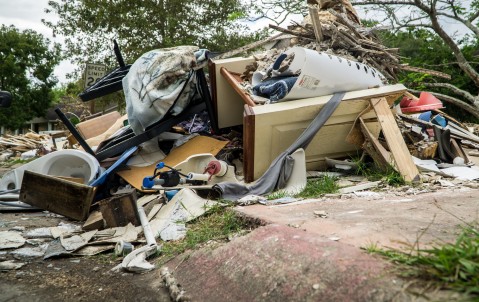
Getting boots on the ground is key for US claims
Michael R Fox, partner at US legal firm Clark & Fox, discusses the need to make sure London has plenty of trusted loss adjusters on site in the US.
What are the most common types of property claims you’re seeing in the US?
Typically, following the types of extreme wind, rain and snow storms we've seen recently, both homeowner and commercial property insureds are filing claims for roof collapses, or wind removing exterior components of the roof. Also, depending on the type of policy, there could be a flood damage claim.
Issues that we also see when it comes to storm claims are problems with matching, where part of an insured’s roof requires replacing but the insured will say they need to replace the entire roof so the colours of the tiles match. Another is where a roof – following a hail storm or wind storm for example – requires total replacement. You might have a situation where the local adjuster says some patching will solve the problem but the insured will have a roofer who says the entire roof needs to be replaced. That leads to a lot of litigation.
Also, with regard to commercial properties, consequential business interruption coverage claims can become quite complex. Storms that cause property damage, disrupt transportation (both public and private) and/or result in power outages, often lead to insureds’ claims seeking compensation for income it would have earned had the storm and resulting events not taken place. These types of claims result in a myriad of issues, such as those involving causation, the nature and length of the loss period, and accounting procedures used to calculate any alleged losses.
How problematical is the 'wind versus water' argument?
Wind versus water always comes up as an issue because a typical commercial or homeowner's policy is not going to cover flood damage - they'll normally get that insurance from the federal flood programme which usually only gives coverage up to a certain amount, such as $250,000 for a typical home. If you have a case where a home or business that has suffered catastrophic loss is more than the flood programme’s limit of insurance, then the insured might say the damage was caused by wind as well.
Was this a problem post Hurricane Sandy?
I dealt with million dollar homes that were completely washed away by Sandy and they only had $250,000 of flood coverage. So obviously they would try and claim it was wind. One of the big issues in the US is the anti-concurrent causation clause which is typical in many policies. This excludes coverage in situations where a covered event and an excluded event contribute concurrently, or sequentially, to a single loss. During a hurricane on the coast you might have water coming in from the ocean damaging a house as well as wind damage; since those events are occurring at the same time and one is usually covered which is wind, and one is excluded which is water, then that wouldn't be a covered loss. Only the damage that occurred that could be specifically attributed to wind, such as shingles blowing off the roof, would be covered. If a portion of the house collapsed it would typically be caused by both wind and water and wouldn't be covered.
It's a highly litigated aspect of US claims and states have different viewpoints as to whether those clauses are sustainable.
How will the recent extreme weather in the US affect the 'wind versus water' debate?
People in the US have been reluctant to buy excess flood policies because they are expensive - even the coverage from the federal government is extremely expensive. Before Sandy, people thought we'd never get a storm like it; they hadn't anticipated that the ocean would come up to their house. After that, people who have an expensive waterfront home have been more likely to buy excess flood policy coverage. The more who do that could help resolve the wind versus flood argument because they will have enough coverage to fix the damage.
What did the industry learn from Hurricane Sandy?
The biggest issue was having the people on the ground to handle the amount of claims. After Sandy came in, there were lots of problems with the local adjusters who couldn't keep up with the claims. When people don't get their claims paid, they get litigious.
The lesson for insurers was to have a catastrophe plan in place. Hurricanes might give a week's warning but typically you're not going to get a month to prepare for it. The catastrophe plan would include having a local independent adjusting firm that you trust and that you know has enough people working for them and will be able to handle a large amount of claims.
Does the geographical separation put London insurers at a disadvantage to US based insurers when it comes to US claims?
London is at a slight disadvantage because the inside claims adjusters in the US are able to get information more quickly than a London adjuster who will be relying on their people in the US to keep them updated. But, this shouldn't be a problem provided a London insurer has people on retention who it knows can handle the task.
Underwriters might also want to provide those local independent adjusters with guidelines and standards in advance of a catastrophe that they want followed, in order to make sure that the information is going to be gathered quickly and effectively.
How can brokers help?
The broker's role from a claims perspective has changed in recent years, with the introduction of electronic claims files for instance, but they are still a conduit between underwriters and the local independent adjusting firm. The brokers can work with those firms to help ensure they are complying with the underwriter's guidelines and standards. Brokers can also assist in keeping insureds and underwriters on the same page by facilitating communication with the insured through the US-located surplus lines wholesaler.
Working closely with the third party administrators is important. If there is a particularly thorny type of claim, brokers can recommend getting lawyers involved quickly to help assist with any potential appraisal process there might be to guide the adjuster in their communications with the insured, the insured's lawyer, or the insured's public adjuster.
What about better communication as a way of reducing litigation?
After Sandy there were lots of law suits from homeowners or business owners unhappy that their claim wasn't covered; they were suing underwriters and their local insurance agents saying that they didn’t tell them that they needed excess flood insurance. London can play a role in making sure that their surplus line wholesalers communicate to the local insurance agents, who are actually selling the policy, that they inform the insureds as to what the policy includes.
The US state governments are also seeking to assist in this process through regulation. Certain states are looking at mandating that insurance policies include a brief one page summary of the key coverages and non-coverages. It is important that underwriters stay abreast of these regulatory changes through their surplus lines wholesalers and advisory US counsel so that they can ensure compliance and avoid litigation in the future.



